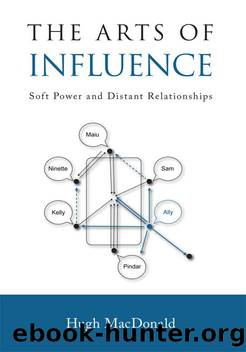The Arts of Influence by Hugh MacDonald

Author:Hugh MacDonald
Language: eng
Format: epub
ISBN: 9781425175764
Publisher: Author Solutions Inc.
Published: 2008-09-11T00:00:00+00:00
CHAPTER 8
Convening:
The Art of Managing Conflict
OK. IF NEGOTIATION is AN exercise in creative problem solving, what about those situations where there really is a conflict between us and someone else, or between people or groups that we work with?
Conflict is normal. Conflict is not only normal, as far as workplace relationships are concerned, conflict is a good thingâor at least helpful.
I can hear you now; youâre thinking, âAre you crazy?â
Not at all. Conflict is good in the same way that pain or bleeding is good. Pain tells us that something is wrong. It lets us know that we need to do something. We can mask the symptom but a better response is to find out what the root cause is and do something about it before things get worse. Itâs the same thing with conflict. If we ignore it, or walk away from it, we are ignoring a problem. We may be making things worse in the long run. To be an effective relationship manager it is necessary to be able to analyze and manage workplace conflictâespecially conflicts that get in our way as we attempt to give advice and get our ideas across and make things happen.
Theories and Models of Workplace Conflict
Conflict occurs within an individual, between people and among the groups that form our world. Conflict is about differencesâreal or perceivedâand despite all thatâs been written about it, there is no accepted or standard definition. It is helpful to think that conflict results from a disabled, or unbalanced, human system. Cathy Costantino and Christina Merchant (1996) suggested that such unbalanced systems are expressions of dissatisfaction with an interaction, process, product or service. A good working definition might be that conflict is the friction caused by actual or imagined differences in interests. More important is that we realize that conflict is normal and natural. It is inherent in the very act of communicating with others.
The value of conflict is reflected in a Chinese proverb, [bu da bu xiang shi]. Roughly translated it means, âWithout a fight, we donât really understand one another.â Lewis Coser (1956), one of the seminal thinkers in the field of conflict analysis, argued that conflict is neither negative nor positive in itself. It is not conflict, therefore, but our reaction to conflict that is good or bad. Without some conflict, no one would challenge the status quo. Conflict is highly functional. It surfaces truth and allows problems to be identified and managed. Looking at it this way, conflict is necessary to grow and to learn. I like it when conflict surfaces at a meeting or during a conversation. Like the civil servant whose job it is to speak truth to power, one of the most important tasks of a relationship manager is to uncover and surface workplace conflictânot to cover it over or ignore it. Only then can we analyze it and do something about it.
The Robbersâ Cave Experiment
Life is full of conflict. To be a member of a group produces conflict as an ordinary and natural part of our âidentityâ.
Download
This site does not store any files on its server. We only index and link to content provided by other sites. Please contact the content providers to delete copyright contents if any and email us, we'll remove relevant links or contents immediately.
| Ethics | Etiquette |
| Fashion & Image | Health & Stress |
| Motivation & Self-Improvement | Work Life Balance |
| Workplace Culture |
Tools of Titans by Timothy Ferriss(8303)
Change Your Questions, Change Your Life by Marilee Adams(7676)
Deep Work by Cal Newport(6961)
Playing to Win_ How Strategy Really Works by A.G. Lafley & Roger L. Martin(6074)
Man-made Catastrophes and Risk Information Concealment by Dmitry Chernov & Didier Sornette(5951)
Digital Minimalism by Cal Newport;(5699)
Big Magic: Creative Living Beyond Fear by Elizabeth Gilbert(5674)
The Slight Edge by Jeff Olson(5376)
Ego Is the Enemy by Ryan Holiday(5344)
The Motivation Myth by Jeff Haden(5174)
The Laws of Human Nature by Robert Greene(5073)
Stone's Rules by Roger Stone(5051)
Tuesdays with Morrie by Mitch Albom(4727)
Eat That Frog! by Brian Tracy(4479)
Rising Strong by Brene Brown(4410)
Skin in the Game by Nassim Nicholas Taleb(4200)
Bullshit Jobs by David Graeber(4136)
The Money Culture by Michael Lewis(4127)
Skin in the Game: Hidden Asymmetries in Daily Life by Nassim Nicholas Taleb(3960)
